
Concept explainers
(a)
Interpretation:
The amount of pressure created when a gas molecule moving in a closed container has to be explained.
Concept Introduction:
Gas pressure
Pressure or Stress is the force applied perpendicular to the surface of an object per unit area.
SI derived unit of pressure is Pascal (Pa).
(a)
Answer to Problem 5.28QP
The pressure in the closed container developed when the gas molecule has a constant bombardment or collisions with the sides of the containers.
Explanation of Solution
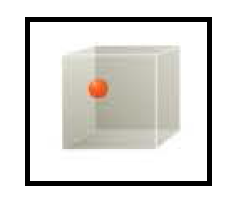
Figure 1
According to kinetic theory of gases the molecules in a container are continuously moving freely. The molecule undergoes collisions within themselves and with the sides of the container which are very small but on an average the collisions are considerable forces on the container. The molecule exerts maximum force at the surface if the angle of incidence is 900.
The summation of all the forces are known as pressure.
The amount of pressure created when a gas molecule moving in a closed container is explained.
(b)
Interpretation:
The amount of pressure created when the gas molecule(s) moving in closed containers A and B has to be explained.
Concept Introduction:
Gas pressure:
Pressure or Stress is the force applied perpendicular to the surface of an object per unit area.
SI derived unit of pressure is Pascal (Pa).
(b)
Answer to Problem 5.28QP
Container B exerts more pressure than the Container A.
Explanation of Solution
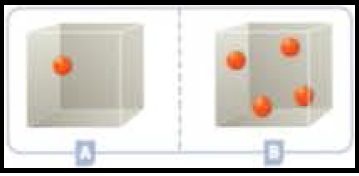
Figure 2
The pressure in the closed container developed when the gas molecules has a constant bombardment or collisions with the sides of the containers.
According to
Since container B having more number of molecules than the container A, container B exerts more pressure.
The amount of pressure created when different number of gas molecules in a closed containers is explained.
(c)
Interpretation:
The amount of pressure has to be explained when the containers C and D contains atoms and molecules.
Concept Introduction:
Gas pressure:
Pressure or Stress is the force applied perpendicular to the surface of an object per unit area.
SI derived unit of pressure is Pascal (Pa).
(c)
Answer to Problem 5.28QP
The pressure in container B is four times the pressure in container A. Since Container B contains four times the molecules in container A.
Explanation of Solution
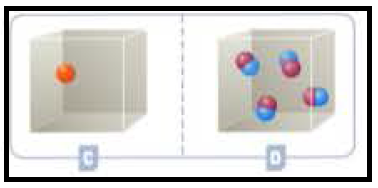
Figure 3
According to Kinetic theory of gases, the more the number of molecules, the more pressure will be in the container. Since container B having four molecules whereas container A has one atom, container B having more pressure than the container A. container is independent of mass but dependent on no of particles.
The amount of pressure was explained when the containers contains atom and molecules.
(d)
Interpretation:
Among the given containers C and D, the container with highest RMS value has to be identified and answer has to be contradicted with the pressure of the container.
Concept Introduction:
Root mean square value:
Where,
(d)
Answer to Problem 5.28QP
Since the atom is lighter than the molecules it will have higher rms speed.
Explanation of Solution
The RMS speed is directly proportional to the square root of
RMS speed doesn’t depends on the pressure of the container, so the pressure of the neither gets support nor contradicts with the RMS value. Because force on the sides of the container doesn’t depend on speed of the particle alone, it does depend on the momentum of the particle
Finally the RMS speed depends on temperature. At constant temperature constant force will be there.
Among the given containers C and D, the container with highest RMS value has been identified and answer has contradicted with the pressure of the container.
(e)
Interpretation:
At the given conditions the pressures among the Containers E and F should be compared.
Concept Introduction:
Gay-Lussac’s law:
Gay-Lussac law derived from the Charles law,
The law states that a sample gas having fixed pressure is directly proportional to the temperature. Since pressure can never be negative and the temperature scale should be absolute minimum.
So the initial and final Pressure will be like
Here,
P1 and P2 are initial and final Pressure.
T1 and T2 are initial and final Temperature.
(e)
Answer to Problem 5.28QP
The pressure in the container F doubles than the pressure in the Container E.
Explanation of Solution
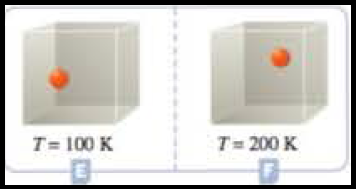
Figure 4
According to Gay lussac law, at equal volumes and equal number of molecules pressure and temperature are directly proportional to each other. So, the containers E and F has equal volumes and equal number of molecules. The temperature in the container F is T = 200 K, and Container E has T = 100 K, according to Gay-Lussac law container F contains double the pressure then the container E.
At the given conditions the pressures among the Containers E and F was compared.
(f)
Interpretation:
At the given conditions the pressures among the Containers G and H should be compared.
Concept Introduction:
Gay-Lussac’s law:
Gay-Lussac law derived from the Charles law,
The law states that a sample gas having fixed pressure is directly proportional to the temperature. Since pressure can never be negative and the temperature scale should be absolute minimum.
So the initial and final Pressure will be like
Here,
P1 and P2 are initial and final Pressure.
T1 and T2 are initial and final Temperature.
(f)
Answer to Problem 5.28QP
The pressure in the container H doubles than the pressure in the Container G.
Explanation of Solution
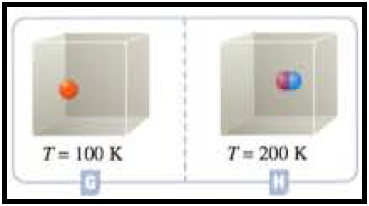
Figure 5
According to Gay lussac law, at equal volumes and equal number of molecules pressure and temperature are directly proportional to each other. So, the containers H and G has equal volumes and equal number of molecules. The temperature in the container H is T = 200 K, and Container G has T = 100 K, according to Gay-Lussac law container H contains double the pressure then the container G. pressure of the container doesn’t depends on the mass of the particle.
At the given conditions the pressures among the Containers G and H was compared.
(g)
Interpretation:
At the given conditions the pressures among the Containers G and H should be compared.
Concept Introduction:
Gay-Lussac’s law:
Gay-Lussac law derived from the Charles law,
The law states that a sample gas having fixed pressure is directly proportional to the temperature. Since pressure can never be negative and the temperature scale should be absolute minimum.
So the initial and final Pressure will be like
Here,
P1 and P2 are initial and final Pressure.
T1 and T2 are initial and final Temperature.
(g)
Answer to Problem 5.28QP
Both the containers I and J will have same pressures.
Explanation of Solution
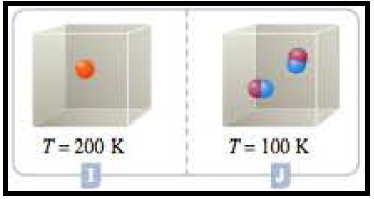
Figure 6
According to Gay-Lussac law, pressure of the container relates to Temperature and number of molecules as well. Here the temperature in container I doubles the temperature J which adequately doubles the pressure. But the number of particles in container J is the double the number of particles in container I, which effectively reduces the pressure by one-half. As whole the pressures in the containers remain same.
At the given conditions the pressures among the Containers G and H was compared.
(h)
Interpretation:
At the given conditions the pressures among the Containers K and L should be compared.
Concept Introduction:
Gay-Lussac’s law:
Gay-Lussac law derived from the Charles law,
The law states that a sample gas having fixed pressure is directly proportional to the temperature. Since pressure can never be negative and the temperature scale should be absolute minimum.
So the initial and final Pressure will be like
Here,
P1 and P2 are initial and final Pressure.
T1 and T2 are initial and final Temperature.
(h)
Answer to Problem 5.28QP
The pressure in the container K six times than the pressure in the Container L
Explanation of Solution
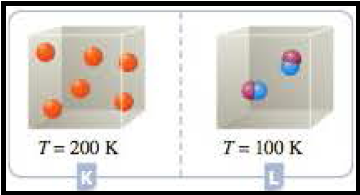
Figure 7
Here in this case, container K has six atoms and T = 200 K. whereas container L has 2 molecules and T=100 K. So the Container K has three times than the particles in container L and the temperature doubles than container L. So the container K has six times more pressure than the container L.
At the given conditions the pressures among the Containers K and L was compared.
Want to see more full solutions like this?
Chapter 5 Solutions
General Chemistry - Standalone book (MindTap Course List)
- > Can the molecule on the right-hand side of this organic reaction be made in good yield from no more than two reactants, in one step, by moderately heating the reactants? esc ? A O O •If your answer is yes, then draw the reactant or reactants in the drawing area below. You can draw the reactants in any arrangement you like. • If your answer is no, check the box under the drawing area instead. olo 18 Ar Explanation Check BB Click and drag to start drawing a structure. 2025 McGraw Hill LLC. All Rights Reserved. Terms of Use | Privacy Center Accessibilityarrow_forwardName the structurearrow_forward> For each pair of substrates below, choose the one that will react faster in a substitution reaction, assuming that: 1. the rate of substitution doesn't depend on nucleophile concentration and 2. the products are a roughly 50/50 mixture of enantiomers. Substrate A Substrate B Faster Rate X CI (Choose one) (Choose one) CI Br Explanation Check Br (Choose one) C 2025 McGraw Hill LLC. All Rights Reserved. Terms of Use | Privacy A F10arrow_forward
- How to draw this mechanism for the foloowing reaction in the foto. thank youarrow_forwardPredict the major products of the following organic reaction: Some important notes: CN A? • Draw the major product, or products, of the reaction in the drawing area below. • If there aren't any products, because no reaction will take place, check the box below the drawing area instead. • Be sure to use wedge and dash bonds when necessary, for example to distinguish between major products that are enantiomers. No reaction. Explanation Check Click and drag to start drawing a structure. 2025 McGraw Hill LLC. All Rights Reserved. Terms of Use Privacy Centerarrow_forwardDraw the major product of the following reaction. Do not draw inorganic byproducts. H3PO4 OHarrow_forward
- Predict the major products of this organic reaction: HBr (1 equiv) Δ ? Some important notes: • Draw the major product, or products, of this reaction in the drawing area below. • You can draw the products in any arrangement you like. • Pay careful attention to the reaction conditions, and only include the major products. • Be sure to use wedge and dash bonds when necessary, for example to distinguish between major products that are enantiomers. • Note that there is only 1 equivalent of HBr reactant, so you need not consider the case of multiple additions. Explanation Check X ©2025 McGraw Hill LLC. All Rights Reserved. Terms of Use | Privacyarrow_forwardFor the structure below, draw the resonance structure that is indicated by the curved arrow(s). Be sure to include formal charges. :ÖH Modify the second structure given to draw the new resonance structure. Include lone pairs and charges in your structure. Use the + and - tools to add/remove charges to an atom, and use the single bond tool to add/remove double bonds.arrow_forwardUsing the table of Reactants and Products provided in the Hints section, provide the major product (with the correct stereochemistry when applicable) for questions below by selecting the letter that corresponds to the exact chemical structures for the possible product. OH conc Hydrochloric acid 40°C Temp A/arrow_forward
- Using arrows to designate the flow of electrons, complete the reaction below and provide a detailed mechanism for the formation of the product OH conc Hydrochloric acid 40°C Temp All chemical structures should be hand drawn on a piece of paper Paragraph BI UAE +varrow_forwarddraw out the following structures plesearrow_forwardDraw everything on a piece of paper outlining the synthesis from acetaldehyde to 2 cyclopentene carboxaldehyde using carbon based reagants with 3 carbons or fewers. Here is the attached image.arrow_forward
 General Chemistry - Standalone book (MindTap Cour...ChemistryISBN:9781305580343Author:Steven D. Gammon, Ebbing, Darrell Ebbing, Steven D., Darrell; Gammon, Darrell Ebbing; Steven D. Gammon, Darrell D.; Gammon, Ebbing; Steven D. Gammon; DarrellPublisher:Cengage Learning
General Chemistry - Standalone book (MindTap Cour...ChemistryISBN:9781305580343Author:Steven D. Gammon, Ebbing, Darrell Ebbing, Steven D., Darrell; Gammon, Darrell Ebbing; Steven D. Gammon, Darrell D.; Gammon, Ebbing; Steven D. Gammon; DarrellPublisher:Cengage Learning Chemistry: The Molecular ScienceChemistryISBN:9781285199047Author:John W. Moore, Conrad L. StanitskiPublisher:Cengage Learning
Chemistry: The Molecular ScienceChemistryISBN:9781285199047Author:John W. Moore, Conrad L. StanitskiPublisher:Cengage Learning World of Chemistry, 3rd editionChemistryISBN:9781133109655Author:Steven S. Zumdahl, Susan L. Zumdahl, Donald J. DeCostePublisher:Brooks / Cole / Cengage Learning
World of Chemistry, 3rd editionChemistryISBN:9781133109655Author:Steven S. Zumdahl, Susan L. Zumdahl, Donald J. DeCostePublisher:Brooks / Cole / Cengage Learning General, Organic, and Biological ChemistryChemistryISBN:9781285853918Author:H. Stephen StokerPublisher:Cengage LearningChemistry: Matter and ChangeChemistryISBN:9780078746376Author:Dinah Zike, Laurel Dingrando, Nicholas Hainen, Cheryl WistromPublisher:Glencoe/McGraw-Hill School Pub Co
General, Organic, and Biological ChemistryChemistryISBN:9781285853918Author:H. Stephen StokerPublisher:Cengage LearningChemistry: Matter and ChangeChemistryISBN:9780078746376Author:Dinah Zike, Laurel Dingrando, Nicholas Hainen, Cheryl WistromPublisher:Glencoe/McGraw-Hill School Pub Co ChemistryChemistryISBN:9781305957404Author:Steven S. Zumdahl, Susan A. Zumdahl, Donald J. DeCostePublisher:Cengage Learning
ChemistryChemistryISBN:9781305957404Author:Steven S. Zumdahl, Susan A. Zumdahl, Donald J. DeCostePublisher:Cengage Learning





